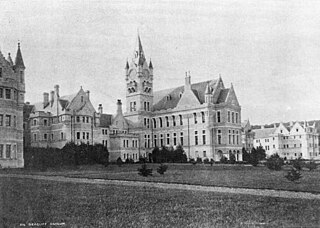A flashover is the near-simultaneous ignition of most of the directly exposed combustible material in an enclosed area. When certain organic materials are heated, they undergo thermal decomposition and release flammable gases. Flashover occurs when the majority of the exposed surfaces in a space are heated to their autoignition temperature and emit flammable gases. Flashover normally occurs at 500 °C (932 °F) or 590 °C (1,100 °F) for ordinary combustibles and an incident heat flux at floor level of 20 kilowatts per square metre (2.5 hp/sq ft).

On Monday, December 1, 1958, a fire broke out at Our Lady of the Angels School in Chicago, Illinois, shortly before classes were to be dismissed for the day. The fire originated in the basement near the foot of a stairway. The elementary school was operated by the Archdiocese of Chicago and had an enrollment of approximately 1600 students. A total of 92 pupils and three nuns ultimately died when smoke, heat, fire, and toxic gases cut off their normal means of egress through corridors and stairways. Many more were injured when they jumped from second-floor windows which, because the building had a raised basement, were nearly as high above ground as a third floor would be on level ground, approximately 25 feet (7.6 m).

Arthur Barnett Ltd, trading as Arthur Barnett and often referred to as Arthur Barnett's, was a department store in Dunedin, New Zealand. Established in 1903 by Arthur Barnett the store first began as a drapery for men and boys, progressing over the years to become one of Dunedin's most successful department stores. As well as their flagship George Street store, Arthur Barnett had stores in Balclutha, Alexandra, Oamaru, and Christchurch. They also briefly had a branch in Melbourne which operated from 1970 to 1977. This branch sold mainly carpeting and furniture. The final Arthur Barnett store and its online store was taken over by Invercargill-based department store chain H & J Smith in 2015.

Ao Tawhiti or Ao Tawhiti Unlimited Discovery is a state area school in Christchurch, New Zealand. It was established by the merging of two separate Christchurch inner city schools; the primary school Discovery 1 and the secondary school Unlimited Paenga Tawhiti.
The following outline is provided as an overview of and topical guide to firefighting:

The Charleston Sofa Super Store fire disaster occurred on the evening of June 18, 2007, in Charleston, South Carolina, and killed nine firefighters. This was the deadliest firefighter disaster in the US since the September 11 attacks. Though the fire was believed to have started in some discarded furniture in the loading dock area, the exact source of ignition remains undetermined. After the fire, the store was demolished and bought by Charleston and a fire station was built nearby.

Seacliff Lunatic Asylum was a psychiatric hospital in Seacliff, New Zealand. When built in the late 19th century, it was the largest building in the country, noted for its scale and extravagant architecture. It became infamous for construction faults resulting in partial collapse, as well as a 1942 fire which destroyed a wooden outbuilding, claiming 37 lives, because the victims were trapped in a locked ward.
The 23rd Street Fire was an incident that took place in the Flatiron District neighborhood of Manhattan, New York City, on October 17, 1966. A group of firefighters from the New York City Fire Department responding to a fire at 7 East 22nd Street entered a building at 6 East 23rd Street as part of an effort to fight the fire. Twelve firefighters were killed after the floor collapsed, the largest loss of life in the department's history until the collapse of the World Trade Center in the September 11 attacks of 2001.
The Luoyang Christmas fire was a major fire that occurred in Luoyang, in China's Henan Province, on 25 December 2000, killing 309 people. It was the second deadliest nightclub fire in history, resulting from welding that sparked flammable materials; while the construction and retail workers in the same building evacuated, the nightclub patrons were forgotten about and were overwhelmed in a flashover.
The Sennichi Department Store Building fire occurred in Sennichimae, Minami-ku, Osaka, Japan on May 13, 1972. The fire killed at least 118 people and injured another 78. It was the deadliest department store fire in Japan. The building that housed the department store also contained various other businesses, including a cabaret. All of the victims had been in the cabaret.

Colombo Street is a main road of the city of Christchurch, New Zealand. It runs south-north through the centre of Christchurch with a break at Cathedral Square. As with many other central Christchurch streets, it is named for a colonial Anglican bishopric, Colombo, Sri Lanka in what at the time was known as Ceylon. Parts of the street which run through Sydenham were known as Addison Street during the 1880s, and some parts were known as Colombo Road.

The CTV Building was the headquarters of Canterbury Television and other companies. Located on the corner of Cashel and Madras Streets in Christchurch Central City, New Zealand. It became one of the symbols of the February 2011 Christchurch earthquake after 115 people lost their lives when the building collapsed during the disaster; the deaths made up about 60% of the earthquake's total fatalities.

City Mall is the main pedestrian mall in the central city of Christchurch, New Zealand, comprising two sections of Cashel Street plus the Bridge of Remembrance and one section of High Street. It is also known colloquially as Cashel Mall. The Bridge of Remembrance was pedestrianised in 1976. The main mall was closed to traffic on 11 January 1982 and formally reopened as a pedestrian mall on 7 August, but it was not until 1992 that the entire mall was paved. The mall was redeveloped between 2006 and 2009, and track was installed for an expansion of the heritage tram network.

J Ballantyne and Company Ltd, trading as Ballantynes is a Christchurch, New Zealand-based department store operator. Established in 1854, it is New Zealand's oldest department store. Ballantynes is also a member of the Intercontinental Group of Department Stores. Alongside their flagship store in Christchurch Central City, stores also operate in Timaru and Invercargill.
The Kilbirnie Street fire, on Friday 25 August 1972, was a warehouse fire in the Port Eglinton area, on the south side of Glasgow, Scotland, which killed seven Glasgow Fire Service firemen in a flashover while they were trying to rescue a trapped colleague. What started as a routine industrial premises fire resulted in one of the highest losses of life for the UK Fire Service at a single incident in peacetime.

Partridge Jewellers Ltd, trading as Partridge Jewellers is a luxury jewellery manufacturer and retailer operating in New Zealand.

On 11 April 1996, a fire began inside the passenger terminal of Düsseldorf Airport, Germany, killing 17 people. As of 2013, it is the worst structural fire to have occurred in any commercial airport building. According to various sources, between 62 and 88 people were injured. The catastrophic conflagration is considered a prime example for a polystyrene fire, illustrating the flammability of such material. Approximately 1,000 firefighters were involved in extinguishing the blaze, which at the time was the largest fire response in the history of North Rhine-Westphalia.

Container Mall was a temporary mall built from shipping containers in Christchurch Central City, New Zealand. It was a response to the 22 February 2011 Christchurch earthquake, which destroyed most buildings in City Mall, and resulted in the central city being cordoned off from public access while buildings were being demolished. Initially considered a short-term response to the lack of permanent buildings, Re:START was popular with locals and tourists alike and remained open for business until January 2018.

Fire and Emergency New Zealand is New Zealand's main firefighting and emergency services body.

On Tuesday, 22 October 2019, a fire broke out on the roof of the New Zealand International Convention Centre in Auckland, New Zealand. The convention centre is to become part of the SkyCity complex and was undergoing construction by Fletcher Construction, due for completion before the end of the year. The site was occupied by construction workers at the time and was not open to the public.

















